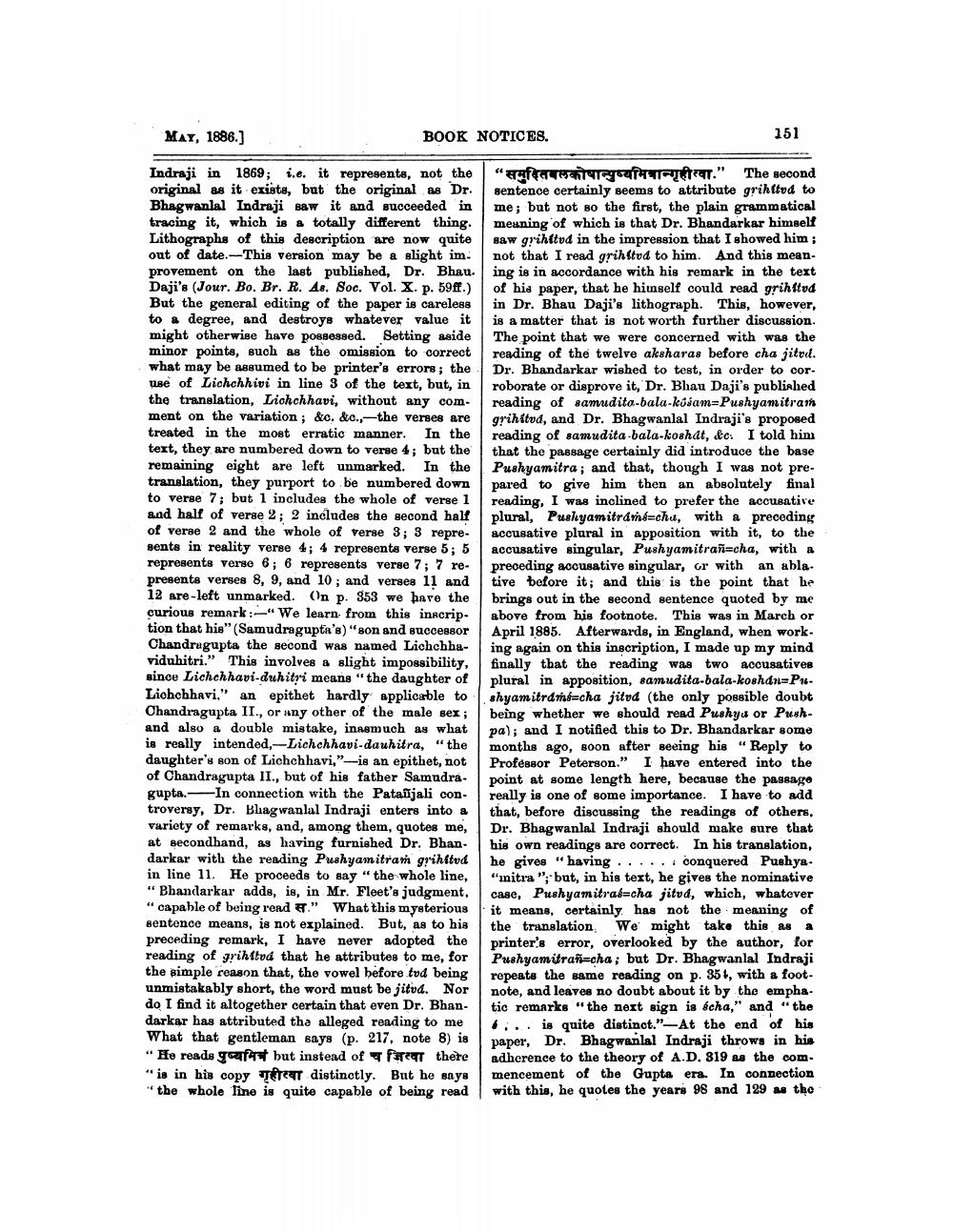________________
MAY, 1886.]
BOOK NOTICES.
151
Indraji in 1869; i.e. it represente, not the original as it existe, but the original as Dr. Bhagwanlal Indraji saw it and succeeded in tracing it, which is a totally different thing. Lithographs of this description are now quite out of date.--This version may be a slight im. provement on the last published, Dr. Bhau. Daji's (Jour. Bo. Br. R. As. Soc. Vol. X. p. 59ff.) But the general editing of the paper is careless to a degree, and destroys whatever value it might otherwise have possessed. Setting aside minor points, such as the omission to correct what may be assumed to be printer's errors; the nge of Lichchhivi in line 3 of the text, but, in the translation, Lichchhavi, without any com. ment on the variation ; &c. &c.,-the verses are treated in the most erratic manner. In the text, they are numbered down to verse 4; but the remaining eight are left unmarked. In the translation, they purport to be numbered down to verse 7; but 1 includes the whole of verse 1 and half of verse 2; 2 includes the second half of verse 2 and the whole of verse 3; 3 represents in reality verse 4; 4 representa verse 5; 5 represents verso 6; 6 represents verse 7; 7 re- presents verses 8, 9, and 10 ; and verses 11 and 12 are left unmarked. On p. 353 we have the curious remark:-"We learn from this inscription that his" (Samudragupta's) son and successor Chandrugupta the second was named Lichchha- viduhitri." This involves a slight impossibility, since Lichchhavi-duhitri means "the daughter of Liohobhavi." an epithet hardly applicable to Chandragupta II., or any other of the male sex ; and also a double mistake, inasmuch as what is really intended-Lichchhavi-dauhitra, "the daughter's son of Lichchhavi,"-is an epithet, not of Chandragupta II., but of his father Samudra. gupta. In connection with the Patasījali con troversy, Dr. Bhagwanlal Indraji enters into a variety of remarks, and, among them, quotes me, at secondhand, as having furnished Dr. Bhan. darkar with the reading Pushyam itrar grihítva in line 11. He proceeds to say "the whole line, "Bhandarkar adds, is, in Mr. Fleet's judgment, "capable of being read " What this mysterious sentence means, is not explained. But, as to his preceding remark, I have never adopted the reading of grihatod that he attributes to me, for the simple reason that, the vowel before tvd being unmistakably short, the word must be jitvd. Nor do I find it altogether certain that even Dr. Bhandarkar has attributed tha alleged reading to me What that gentleman says (p. 217. note 8) is "He reads you but instead of free there " is in his copy Tecar distinctly. But he says "the whole line is quite capable of being read
"araferner gouf ." The second sentence certainly seems to attribute grihftvd to me; but not so the first, the plain grammatical meaning of which is that Dr. Bhandarkar himself saw grihitud in the impression that I showed him; not that I read grihftvd to him. And this mean. ing is in accordance with his remark in the text of his paper, that he himself could read grihftvd in Dr. Bhau Daji's lithograph. This, however, is a matter that is not worth further discussion. The point that we were concerned with was the reading of the twelve aksharas before cha jitvi. Dr. Bhandarkar wished to test, in order to corroborate or disprove it, Dr. Bhau Daji's published reading of samudito-bala-kúšam=Pushyamitran grihitvd, and Dr. Bhagwanlal Indraji's proposed reading of samudita-bala-koshat, &c. I told him that the passage certainly did introduce the base Pushyamitra ; and that, though I was not prepared to give him then an absolutely final reading, I was inclined to prefer the accusative plural, Pushyamitrams=chu, with a preceding accusative plural in apposition with it, to the accusative singular, Pushyamitran-cha, with a preceding accusative singular, or with an abla. tive before it; and this is the point that he brings out in the second sentence quoted by me above from his footnote. This was in March or April 1885. Afterwards, in England, when work. ing again on this inscription, I made up my mind finally that the reading was two accusatives plural in apposition, samudita-bala-koshdn-Pshyamitrdmt=cha jitvd (the only possible doubt being whether we should read Pushyu or Pushpa); and I notified this to Dr. Bhandarkar some months ago, soon after seeing his "Reply to Professor Peterson.” I have entered into the point at some length here, because the passage really is one of some importance. I have to add that, before discussing the readings of others, Dr. Bhagwanlal Indraji should make sure that his own readings are correct. In his translation, he gives “having .....conquered Pushya. "mitra "; but, in his text, he gives the nominative case, Pushyamitras-cha jitvd, which, whatever it means, certainly has not the meaning of the translation. We might take this as a printer's error, overlooked by the author, for Pushyamitrañ=cha; but Dr. Bhagwanlal Indraji repeats the same reading on p. 351, with a foot. note, and leaves no doubt about it by the emphatic remarks "the next sign is bcha," and "the ..... is quite distinct."- At the end of his paper, Dr. Bhagwanlal Indraji throws in his adherence to the theory of A.D. 819 me the commencement of the Gupta era. In connection with this, he quotes the years 98 and 129 as the




